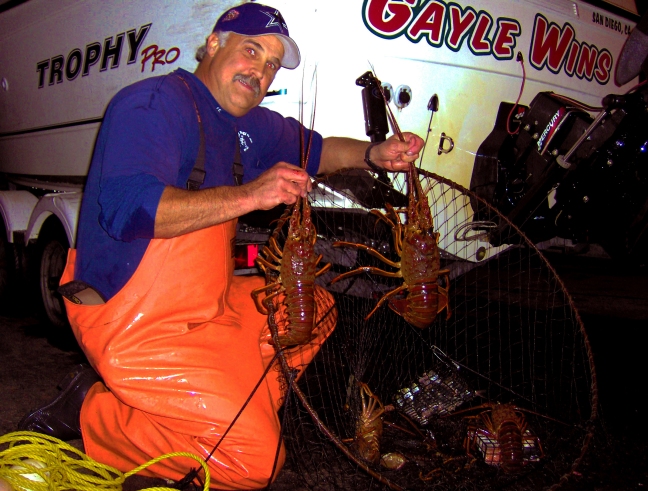Of all the lobsters found around the North American coast, the California spiny lobster (Panulirus interruptus) is the only variety that supports a recreational hoop net fishery. The others, such as the American lobster (Homarus americanus) and the Florida spiny lobster (Panulirus argus) only allow the Crustacean to be taken by hand by sport divers.
The habitat for California spiny lobster ranges from Monterey Bay south to Manzanillo in the Republic of Mexico. They generally congregate in and around submerged structure and, although they are taken by hoop netters at much shallower depths, can inhabit water as deep as 250 feet.
California DFG regulations now requires that lobster hoop netters fill out a separate ‘report card’ regarding their catch, in addition to having an accurate measuring gage and valid saltwater fishing license in their possession. Aside from that, the legal take limit of 7 spiny lobsters per angler a day is quite generous when you consider the going price at the fish market for an equal amount of product.
While it is certainly possible to be successful catching lobster with a hoop net from a pier, wharf or bayside dock, you are better off working from a small boat or kayak that allows you to move around until you can locate a place where lobsters are ‘on the crawl’. Most netting is done from dusk on, since lobster tend to be most active after dark.
Avoid fishing during periods of strong tidal flow. The intensity of the water movement will likely play havoc with your hoop net and tackle, as well as dislodging anything that you might have been lucky enough to catch under such conditions.
A spiny lobster must measure at least 3½” from the point directly between the eyes to the end of the carapace, where the segmented tail begins. A minimum sized spiny weighs in at about 1½ pounds, however it is possible for them to grow up to 20 pounds or more. Some say that the larger a spiny lobster is, the tougher the flesh. Although that might be true under some circumstances, I can personally verify that specimens weighing up to 8 pounds I have been fortunate enough to enjoy with friends have been absolutely scrumptious.
There are a variety of hoop nets out there. Although the most expensive, in my opinion the best ones designed and manufactured by Promar, which offers several models that can be matched to your individual needs.
Most hoop nets come with about 100 feet of nylon line, a few small buoys and a bait pouch; but there are a few more things that you should have on hand before actually using it. These include a valid California fishing license for all anglers 16 years of age or older, a certified lobster gauge, a durable pair of work or garden gloves, a head lamp and lantern or powerful flashlight, a bait cutting knife and a pair of needle nose pliers and cutting dykes. And in the event of a mishap, a well-equipped first aid kit is also a necessity.
It is also a good idea to replace the small floats that come with the net with full sized net buoys, which should be festooned with reflective tape to make them more visible at night. Because of the over-proliferation of California sea lions, it is also advisable to replace your bait pouch with a metal bait cage to discourage encroachment on your net.
The best baits are strong smelling and oily, such as fish heads and carcasses. Bonito, mackerel and salmon byproducts are perfectly suited to this application.
Current regulations permit individual anglers to fish with up to 5 hoop nets at a time. Given that each net you drop should be rapidly pulled up about every 10 minutes or so to check for lobster and occasionally replace bait, you can be kept extremely busy if you are fishing with everything that the law allows.
